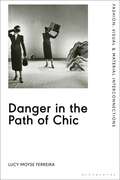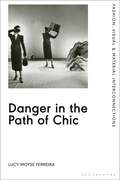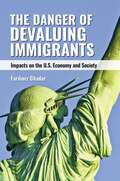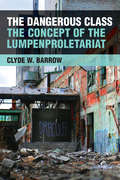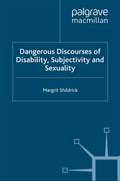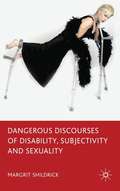- Table View
- List View
Danger in Police Culture: Perspectives from South Africa
by Gráinne PerkinsDanger in Police Culture: Perspectives from South Africa offers a fresh perspective on how officers understand, interpret and construct danger. With unique insight from working with uniformed and detective police, the author breaks new ground as the first researcher to work alongside a Tactical Response Team in South Africa. Through ethnographic research in South Africa, Perkins explores the lived experiences of police navigating danger and death. Reframing the question of what makes policing dangerous, the author employs a theoretical framework as a prism, illuminating ambiguous ideas shaping perceptions of danger in police culture. A vivid portrayal of how danger is materialized through risk reduction strategies and artefacts, dramatized through memorialization and normalized in daily police practices, Perkins concludes by reflecting on policy developments aimed at addressing the understanding and influence of danger in contemporary policing. Underscoring the need to reconsider the concept of danger in policing, this is a much-needed assessment of its understanding and impact on contemporary police work. In support of the Perkins Síochána Scholarship, the author’s proceeds from the sale of this book will be used to fund the continuing development of South African graduate students in Criminal Justice and Criminology studies in the Global South.
Danger in Police Culture: Perspectives from South Africa
by Gráinne PerkinsDanger in Police Culture: Perspectives from South Africa offers a fresh perspective on how officers understand, interpret and construct danger. With unique insight from working with uniformed and detective police, the author breaks new ground as the first researcher to work alongside a Tactical Response Team in South Africa. Through ethnographic research in South Africa, Perkins explores the lived experiences of police navigating danger and death. Reframing the question of what makes policing dangerous, the author employs a theoretical framework as a prism, illuminating ambiguous ideas shaping perceptions of danger in police culture. A vivid portrayal of how danger is materialized through risk reduction strategies and artefacts, dramatized through memorialization and normalized in daily police practices, Perkins concludes by reflecting on policy developments aimed at addressing the understanding and influence of danger in contemporary policing. Underscoring the need to reconsider the concept of danger in policing, this is a much-needed assessment of its understanding and impact on contemporary police work. In support of the Perkins Síochána Scholarship, the author’s proceeds from the sale of this book will be used to fund the continuing development of South African graduate students in Criminal Justice and Criminology studies in the Global South.
Danger in the Path of Chic: Violence in Fashion between the Wars (Fashion: Visual & Material Interconnections)
by Lucy Moyse FerreiraDuring the interwar years, a proliferation of violence encroached upon the glossy, idealistic world of fashion: from the curiously common appearance of dismembered heads in fashion illustration, to seemingly torturous techniques and devices advertised by beauty imagery, even extending to garments designed to look assaulted and destroyed. Danger in the Path of Chic brings this disturbing imagery to light for the first time, proposing new directions for historians of fashion, violence and culture in the interwar years.Concentrating on London, Paris and New York as fashion centres and political allies, the volume explores why horror manifested itself in this way, at this time, and in a sphere that is usually perceived as being built on fantasy and escape. In doing so, Danger in the Path of Chic situates fashion within the very real social, psychological, economic and political traumas of the period.
Danger in the Path of Chic: Violence in Fashion between the Wars (Fashion: Visual & Material Interconnections)
by Lucy Moyse FerreiraDuring the interwar years, a proliferation of violence encroached upon the glossy, idealistic world of fashion: from the curiously common appearance of dismembered heads in fashion illustration, to seemingly torturous techniques and devices advertised by beauty imagery, even extending to garments designed to look assaulted and destroyed. Danger in the Path of Chic brings this disturbing imagery to light for the first time, proposing new directions for historians of fashion, violence and culture in the interwar years.Concentrating on London, Paris and New York as fashion centres and political allies, the volume explores why horror manifested itself in this way, at this time, and in a sphere that is usually perceived as being built on fantasy and escape. In doing so, Danger in the Path of Chic situates fashion within the very real social, psychological, economic and political traumas of the period.
The Danger of Devaluing Immigrants: Impacts on the U.S. Economy and Society
by Fariborz GhadarDespite deep divisions on the issue of immigration, this book shows that immigration promotes economic innovation, expands the job market, and contributes to diversity and creativity in the United States.Immigration, as a conduit for bringing new talent, ideas, and inventions into the United States, is essential to the success and vitality of our economy and society. In this timely book, researched and written by the Immigration Book Project Team at Penn State University, immigration is approached from historical, economic, business, and sociological perspectives in order to argue that treatment of immigrants must reflect and applaud their critical roles in supporting and leading the economic, social, cultural, and political institutions of civil society.Approaching immigration as both a socioeconomic phenomenon and a matter of public policy, The Danger of Devaluing Immigrants offers demographics and statistics on workforce participation and job creation along with stories of individual immigrantS&Rsquo; contributions to the economy and society. It supports the idea that, when immigration is challenged in the political sphere, we must not lose sight of the valuable contributions that immigrants have made-and will continue to make-to our democracy.
The Danger of Devaluing Immigrants: Impacts on the U.S. Economy and Society
by Fariborz GhadarDespite deep divisions on the issue of immigration, this book shows that immigration promotes economic innovation, expands the job market, and contributes to diversity and creativity in the United States.Immigration, as a conduit for bringing new talent, ideas, and inventions into the United States, is essential to the success and vitality of our economy and society. In this timely book, researched and written by the Immigration Book Project Team at Penn State University, immigration is approached from historical, economic, business, and sociological perspectives in order to argue that treatment of immigrants must reflect and applaud their critical roles in supporting and leading the economic, social, cultural, and political institutions of civil society.Approaching immigration as both a socioeconomic phenomenon and a matter of public policy, The Danger of Devaluing Immigrants offers demographics and statistics on workforce participation and job creation along with stories of individual immigrantS&Rsquo; contributions to the economy and society. It supports the idea that, when immigration is challenged in the political sphere, we must not lose sight of the valuable contributions that immigrants have made-and will continue to make-to our democracy.
Dangerous amusements: Leisure, the young working class and urban space in Britain, <i>c</i>. 1870–1939 (Studies in Popular Culture)
by Laura HarrisonIn neighbourhoods and public spaces across Britain, young working people walked out together, congregated in the streets, and paraded up and down on the ‘monkey parades’. The beginnings of a distinct youth culture can be traced to the late nineteenth century, and the street and neighbourhood provided its forum. Dangerous amusements explores these sites of leisure and courtship, examining how young working-class men and women engaged with their environment. Drawing on an extensive range of sources, from newspapers and institutional records to oral histories and autobiography, this book traces the movements of young people across space. Exploring the relationship between the leisure lives of the young working class and urban space, this book offers a sensitive reappraisal of working-class youth and will be essential reading for historians of modern Britain.
Dangerous amusements: Leisure, the young working class and urban space in Britain, <i>c</i>. 1870–1939 (Studies in Popular Culture)
by Laura HarrisonIn neighbourhoods and public spaces across Britain, young working people walked out together, congregated in the streets, and paraded up and down on the ‘monkey parades’. The beginnings of a distinct youth culture can be traced to the late nineteenth century, and the street and neighbourhood provided its forum. Dangerous amusements explores these sites of leisure and courtship, examining how young working-class men and women engaged with their environment. Drawing on an extensive range of sources, from newspapers and institutional records to oral histories and autobiography, this book traces the movements of young people across space. Exploring the relationship between the leisure lives of the young working class and urban space, this book offers a sensitive reappraisal of working-class youth and will be essential reading for historians of modern Britain.
Dangerous and Severe - Process, Programme and Person: Grendon's Work (PDF)
by Mark MorrisHMP Grendon hosts the UK's only prison-based therapeutic community, inhabited by around 200 residents, almost all convicted of crimes against the person, and about half of whom have killed. This is an inside account of the work, and the theory behind the work, carried out at a prison which not only exemplifies the best in prison philosophy, but also a pioneering approach to the treatment of psychopaths. Previously the Director of Therapies at Grendon, Mark Morris provides a unique insight into the work of this experimental prison regime. He tracks its history from the 1950s, and describes how its approaches have evolved over the decades. He explores Grendon's status as a provider of a psychological therapy, and positions its treatment process as a therapeutic community, explaining why this approach is so appropriate and effective for helping prisoners with personality disorders, and how the prison environment can help in the rehabilitation of offenders.
Dangerous Bodies: New Global Perspectives on Fashion and Transgression (Palgrave Studies in Fashion and the Body)
by Royce Mahawatte Jacki WillsonThis edited book brings together new perspectives on fashion, the body, and politics. The intention of this collection is to explore the cultural intersection between bodies, fashion, and transgression, often in the most unlikely of locations. Bodies are political players in culture and the authors gathered here ask a range of pressing questions. What role do fashioned bodies play in resistance, in meeting governmental boundaries or institutional power? Arguably, fashion is an aspect of modern warfare and style can defend and attack in cultural space. So, how do fashioned bodies occupy the grey area between social control and the resistance to power? This book is interdisciplinary and international, with contributors situated within a broad range of disciplines including Art History and Critical Practice, Cultural Studies, Fashion Critical Studies, Film and Literary Studies, Performance Studies, Politics and International Studies, Sociology, Gender, Queer, LGBTI, and Critical Race Studies.
Dangerous bodies: Historicising the gothic corporeal
by Marie Mulvey-RobertsThrough an investigation of the body and its oppression by the church, the medical profession and the state, this book reveals the actual horrors lying beneath fictional horror in settings as diverse as the monastic community, slave plantation, operating theatre, Jewish ghetto and battlefield trench. The book provides original readings of canonical Gothic literary and film texts including The Castle of Otranto, The Monk, Frankenstein, Dracula and Nosferatu. This collection of fictionalised dangerous bodies is traced back to the effects of the English Reformation, Spanish Inquisition, French Revolution, Caribbean slavery, Victorian medical malpractice, European anti-Semitism and finally warfare, ranging from the Crimean up to the Vietnam War. The endangered or dangerous body lies at the centre of the clash between victim and persecutor and has generated tales of terror and narratives of horror, which function to either salve, purge or dangerously perpetuate such oppositions. This ground-breaking book will be of interest to academics and students of Gothic studies, gender and film studies and especially to readers interested in the relationship between history and literature.
Dangerous bodies: Historicising the gothic corporeal
by Marie Mulvey-RobertsThrough an investigation of the body and its oppression by the church, the medical profession and the state, this book reveals the actual horrors lying beneath fictional horror in settings as diverse as the monastic community, slave plantation, operating theatre, Jewish ghetto and battlefield trench. The book provides original readings of canonical Gothic literary and film texts including The Castle of Otranto, The Monk, Frankenstein, Dracula and Nosferatu. This collection of fictionalised dangerous bodies is traced back to the effects of the English Reformation, Spanish Inquisition, French Revolution, Caribbean slavery, Victorian medical malpractice, European anti-Semitism and finally warfare, ranging from the Crimean up to the Vietnam War. The endangered or dangerous body lies at the centre of the clash between victim and persecutor and has generated tales of terror and narratives of horror, which function to either salve, purge or dangerously perpetuate such oppositions. This ground-breaking book will be of interest to academics and students of Gothic studies, gender and film studies and especially to readers interested in the relationship between history and literature.
Dangerous Brown Men: Exploiting Sex, Violence and Feminism in the 'War on Terror'
by Professor Gargi BhattacharyyaWhy is the public presentation of the war on terror suffused with sexualised racism?What does this tell us about ideas of gender, sexuality, religious and political identity and the role of the state in the Western powers?Can we diffuse inter-ethnic conflicts and change the way the West pursues its security agenda by understanding the role of sexualised racism in the war on terror?In asking such questions, Gargi Bhattacharyya considers how the concepts of imperialism, feminism, terror and security can be applied, in order to build on the influential debates about the sexualised character of colonialism. She examines the way in which western imperial violence has been associated with the rhetoric of rights and democracy - a project of bombing for freedom that has called into question the validity of western conceptions of democracy, rights and feminism.Such rhetoric has given rise to actions that go beyond simply protecting western interests or securing access to scarce resources and appear to be beyond instrumental reason. The articulations of racism that appear with the war on terror are animated by fears and sexual fantasies inexplicable by rational interest alone. There can be no resolution to this seemingly endless conflict without understanding the highly sexualised racism that animates it. Such an understanding threatens to pierce the heart of imperial relations, revealing their intense contradictions and uncovering attempts to normalise violent expropriation.
Dangerous Brown Men: Exploiting Sex, Violence and Feminism in the 'War on Terror'
by Professor Gargi BhattacharyyaWhy is the public presentation of the war on terror suffused with sexualised racism?What does this tell us about ideas of gender, sexuality, religious and political identity and the role of the state in the Western powers?Can we diffuse inter-ethnic conflicts and change the way the West pursues its security agenda by understanding the role of sexualised racism in the war on terror?In asking such questions, Gargi Bhattacharyya considers how the concepts of imperialism, feminism, terror and security can be applied, in order to build on the influential debates about the sexualised character of colonialism. She examines the way in which western imperial violence has been associated with the rhetoric of rights and democracy - a project of bombing for freedom that has called into question the validity of western conceptions of democracy, rights and feminism.Such rhetoric has given rise to actions that go beyond simply protecting western interests or securing access to scarce resources and appear to be beyond instrumental reason. The articulations of racism that appear with the war on terror are animated by fears and sexual fantasies inexplicable by rational interest alone. There can be no resolution to this seemingly endless conflict without understanding the highly sexualised racism that animates it. Such an understanding threatens to pierce the heart of imperial relations, revealing their intense contradictions and uncovering attempts to normalise violent expropriation.
The Dangerous Class: The Concept of the Lumpenproletariat
by Clyde BarrowMarx and Engels’ concept of the “lumpenproletariat,” or underclass (an anglicized, politically neutral term), appears in The Communist Manifesto and other writings. It refers to “the dangerous class, the social scum, that passively rotting mass thrown off by the lowest layers of old society,” whose lowly status made its residents potential tools of the capitalists against the working class. Surprisingly, no one has made a substantial study of the lumpenproletariat in Marxist thought until now. Clyde Barrow argues that recent discussions about the downward spiral of the American white working class (“its main problem is that it is not working”) have reactivated the concept of the lumpenproletariat, despite long held belief that it is a term so ill-defined as not to be theoretical. Using techniques from etymology, lexicology, and translation, Barrow brings analytical coherence to the concept of the lumpenproletariat, revealing it to be an inherent component of Marx and Engels’ analysis of the historical origins of capitalism. However, a proletariat that is destined to decay into an underclass may pose insurmountable obstacles to a theory of revolutionary agency in post-industrial capitalism. Barrow thus updates historical discussions of the lumpenproletariat in the context of contemporary American politics and suggests that all post-industrial capitalist societies now confront the choice between communism and dystopia.
Dangerous Decisions: Problem Solving in Tomorrow's World
by E. MumfordIn a world where technology is continually advancing, and problems are becoming more and more complex, established practices for decision making and problem solving are no longer effective. In this new book, however, Enid Mumford draws on her wealth of experience in management, business schools, and working with the police and other professional problem solvers to show us how to tackle complex problems efficiently. With drugs and cyber-crime as her main examples Professor Mumford shows how these topical, yet apparently permanent problems, could be approached. She does this by looking at how the criminals themselves have overcome legal obstacles, and other problems to make the drug trafficking industry the second largest in the world today, and the relative newcomer, electronic fraud, a multi-billion dollar problem already. These crimes, which in themselves lead to more crime from petty theft to support a drug habit, to international money laundering, are incredibly complex, and yet the book shows us that there is not only a way forward with these issues, but a way to approach all complex problems with efficiency and competency, wherever they occur in our lives.
Dangerous Designs: Asian Women Fashion the Diaspora Economies
by Parminder BhachuIn late-1990s Britain, the salwaar-kameez or 'Punjabi suit' emerged as a high-fashion garment. Popular both on the catwalk and on the street, it made front-page news when worn by Diana, Princess of Wales and by Cherie Booth, the wife of UK Prime Minister Tony Blair.In her ethnography of the local and global design economies established by Asian women fashion entrepreneurs, Parminder Bhachu focuses on the transformation of the salwaar-kameez from negatively coded 'ethnic clothing' to a global garment fashionable both on the margins and in the mainstream. Exploring the design and sewing businesses, shops and street fashions in which this revolution has taken place, she shows how the salwaar-kameez is today at the heart of new economic micro-markets which themselves represent complex, powerfully coded means of cultural dialogue and racial politics. The innovative designs of second-generation British Asian women are drawn from characteristically improvisational migrant cultural codes. Through their hybrid designs and creation of new aesthetics, these women cross cultural boundaries, battling with racism and redefining both Asian and British identities. At the same time, their border-crossing commercial entrepreneurship produces new diaspora economies which give them control over many economic, aesthetic, cultural and technological resources. In this way, the processes of global capitalism are gendered, racialized and localized through the interventions of diasporic women from the margins.
Dangerous Designs: Asian Women Fashion the Diaspora Economies
by Parminder BhachuIn late-1990s Britain, the salwaar-kameez or 'Punjabi suit' emerged as a high-fashion garment. Popular both on the catwalk and on the street, it made front-page news when worn by Diana, Princess of Wales and by Cherie Booth, the wife of UK Prime Minister Tony Blair.In her ethnography of the local and global design economies established by Asian women fashion entrepreneurs, Parminder Bhachu focuses on the transformation of the salwaar-kameez from negatively coded 'ethnic clothing' to a global garment fashionable both on the margins and in the mainstream. Exploring the design and sewing businesses, shops and street fashions in which this revolution has taken place, she shows how the salwaar-kameez is today at the heart of new economic micro-markets which themselves represent complex, powerfully coded means of cultural dialogue and racial politics. The innovative designs of second-generation British Asian women are drawn from characteristically improvisational migrant cultural codes. Through their hybrid designs and creation of new aesthetics, these women cross cultural boundaries, battling with racism and redefining both Asian and British identities. At the same time, their border-crossing commercial entrepreneurship produces new diaspora economies which give them control over many economic, aesthetic, cultural and technological resources. In this way, the processes of global capitalism are gendered, racialized and localized through the interventions of diasporic women from the margins.
Dangerous Discourses of Disability, Subjectivity and Sexuality
by M. ShildrickThis innovative and adventurous work, now in paperback, uses broadly feminist and postmodernist modes of analysis to explore what motivates damaging attitudes and practices towards disability. The book argues for the significance of the psycho-social imaginary and suggests a way forward in disability's queering of normative paradigms.
Dangerous Discourses Of Disability, Subjectivity And Sexuality
by Margrit ShildrickThis innovative and adventurous work, now in paperback, uses broadly feminist and postmodernist modes of analysis to explore what motivates damaging attitudes and practices towards disability. The book argues for the significance of the psycho-social imaginary and suggests a way forward in disability's queering of normative paradigms.
Dangerous Discourses Of Disability, Subjectivity And Sexuality (PDF)
by Margrit ShildrickThis innovative and adventurous work, now in paperback, uses broadly feminist and postmodernist modes of analysis to explore what motivates damaging attitudes and practices towards disability. The book argues for the significance of the psycho-social imaginary and suggests a way forward in disability's queering of normative paradigms.
Dangerous Earth: What We Wish We Knew about Volcanoes, Hurricanes, Climate Change, Earthquakes, and More
by Ellen PragerThe Earth is a beautiful and wondrous planet, but also frustratingly complex and, at times, violent: much of what has made it livable can also cause catastrophe. Volcanic eruptions create land and produce fertile, nutrient-rich soil, but they can also bury forests, fields, and entire towns under ash, mud, lava, and debris. The very forces that create and recycle Earth’s crust also spawn destructive earthquakes and tsunamis. Water and wind bring and spread life, but in hurricanes they can leave devastation in their wake. And while it is the planet’s warmth that enables life to thrive, rapidly increasing temperatures are causing sea levels to rise and weather events to become more extreme. Today, we know more than ever before about the powerful forces that can cause catastrophe, but significant questions remain. Why can’t we better predict some natural disasters? What do scientists know about them already? What do they wish they knew? In Dangerous Earth, marine scientist and science communicator Ellen Prager explores the science of investigating volcanoes, earthquakes, tsunamis, hurricanes, landslides, rip currents, and—maybe the most perilous hazard of all—climate change. Each chapter considers a specific hazard, begins with a game-changing historical event (like the 1980 eruption of Mt. St. Helens or the landfall and impacts of Hurricane Harvey), and highlights what remains unknown about these dynamic phenomena. Along the way, we hear from scientists trying to read Earth’s warning signs, pass its messages along to the rest of us, and prevent catastrophic loss. A sweeping tour of some of the most awesome forces on our planet—many tragic, yet nonetheless awe-inspiring—Dangerous Earth is an illuminating journey through the undiscovered, unresolved, and in some cases unimagined mysteries that continue to frustrate and fascinate the world’s leading scientists: the “wish-we-knews” that ignite both our curiosity and global change.
Dangerous Earth: What We Wish We Knew about Volcanoes, Hurricanes, Climate Change, Earthquakes, and More
by Ellen PragerThe Earth is a beautiful and wondrous planet, but also frustratingly complex and, at times, violent: much of what has made it livable can also cause catastrophe. Volcanic eruptions create land and produce fertile, nutrient-rich soil, but they can also bury forests, fields, and entire towns under ash, mud, lava, and debris. The very forces that create and recycle Earth’s crust also spawn destructive earthquakes and tsunamis. Water and wind bring and spread life, but in hurricanes they can leave devastation in their wake. And while it is the planet’s warmth that enables life to thrive, rapidly increasing temperatures are causing sea levels to rise and weather events to become more extreme. Today, we know more than ever before about the powerful forces that can cause catastrophe, but significant questions remain. Why can’t we better predict some natural disasters? What do scientists know about them already? What do they wish they knew? In Dangerous Earth, marine scientist and science communicator Ellen Prager explores the science of investigating volcanoes, earthquakes, tsunamis, hurricanes, landslides, rip currents, and—maybe the most perilous hazard of all—climate change. Each chapter considers a specific hazard, begins with a game-changing historical event (like the 1980 eruption of Mt. St. Helens or the landfall and impacts of Hurricane Harvey), and highlights what remains unknown about these dynamic phenomena. Along the way, we hear from scientists trying to read Earth’s warning signs, pass its messages along to the rest of us, and prevent catastrophic loss. A sweeping tour of some of the most awesome forces on our planet—many tragic, yet nonetheless awe-inspiring—Dangerous Earth is an illuminating journey through the undiscovered, unresolved, and in some cases unimagined mysteries that continue to frustrate and fascinate the world’s leading scientists: the “wish-we-knews” that ignite both our curiosity and global change.
Dangerous Earth: What We Wish We Knew about Volcanoes, Hurricanes, Climate Change, Earthquakes, and More
by Ellen PragerThe Earth is a beautiful and wondrous planet, but also frustratingly complex and, at times, violent: much of what has made it livable can also cause catastrophe. Volcanic eruptions create land and produce fertile, nutrient-rich soil, but they can also bury forests, fields, and entire towns under ash, mud, lava, and debris. The very forces that create and recycle Earth’s crust also spawn destructive earthquakes and tsunamis. Water and wind bring and spread life, but in hurricanes they can leave devastation in their wake. And while it is the planet’s warmth that enables life to thrive, rapidly increasing temperatures are causing sea levels to rise and weather events to become more extreme. Today, we know more than ever before about the powerful forces that can cause catastrophe, but significant questions remain. Why can’t we better predict some natural disasters? What do scientists know about them already? What do they wish they knew? In Dangerous Earth, marine scientist and science communicator Ellen Prager explores the science of investigating volcanoes, earthquakes, tsunamis, hurricanes, landslides, rip currents, and—maybe the most perilous hazard of all—climate change. Each chapter considers a specific hazard, begins with a game-changing historical event (like the 1980 eruption of Mt. St. Helens or the landfall and impacts of Hurricane Harvey), and highlights what remains unknown about these dynamic phenomena. Along the way, we hear from scientists trying to read Earth’s warning signs, pass its messages along to the rest of us, and prevent catastrophic loss. A sweeping tour of some of the most awesome forces on our planet—many tragic, yet nonetheless awe-inspiring—Dangerous Earth is an illuminating journey through the undiscovered, unresolved, and in some cases unimagined mysteries that continue to frustrate and fascinate the world’s leading scientists: the “wish-we-knews” that ignite both our curiosity and global change.
Dangerous Earth: What We Wish We Knew about Volcanoes, Hurricanes, Climate Change, Earthquakes, and More
by Ellen PragerThe Earth is a beautiful and wondrous planet, but also frustratingly complex and, at times, violent: much of what has made it livable can also cause catastrophe. Volcanic eruptions create land and produce fertile, nutrient-rich soil, but they can also bury forests, fields, and entire towns under ash, mud, lava, and debris. The very forces that create and recycle Earth’s crust also spawn destructive earthquakes and tsunamis. Water and wind bring and spread life, but in hurricanes they can leave devastation in their wake. And while it is the planet’s warmth that enables life to thrive, rapidly increasing temperatures are causing sea levels to rise and weather events to become more extreme. Today, we know more than ever before about the powerful forces that can cause catastrophe, but significant questions remain. Why can’t we better predict some natural disasters? What do scientists know about them already? What do they wish they knew? In Dangerous Earth, marine scientist and science communicator Ellen Prager explores the science of investigating volcanoes, earthquakes, tsunamis, hurricanes, landslides, rip currents, and—maybe the most perilous hazard of all—climate change. Each chapter considers a specific hazard, begins with a game-changing historical event (like the 1980 eruption of Mt. St. Helens or the landfall and impacts of Hurricane Harvey), and highlights what remains unknown about these dynamic phenomena. Along the way, we hear from scientists trying to read Earth’s warning signs, pass its messages along to the rest of us, and prevent catastrophic loss. A sweeping tour of some of the most awesome forces on our planet—many tragic, yet nonetheless awe-inspiring—Dangerous Earth is an illuminating journey through the undiscovered, unresolved, and in some cases unimagined mysteries that continue to frustrate and fascinate the world’s leading scientists: the “wish-we-knews” that ignite both our curiosity and global change.


